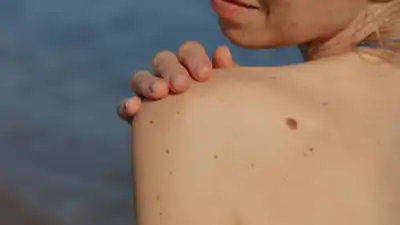Time & age are two common factors that affect the transformation of our skin. Every individual has certain unique skin features, moles or freckles being the most common ones. Usually, moles appear as birthmarks and do not pose any cause for concern.
Moles, most known as nevi, are small benign, regular looking skin growths caused by a cluster of melanocytes or pigment producing cells. Though unusual, one of the most severe forms of skin cancer, known as melanoma (a type of skin cancer developed from melanin producing cells), can look like a mole.
If diagnosed in time, skin cancer can be treated successfully. However, one must possess a basic understanding of the kinds of skin cancer, the risks, and preventive measures to maintain overall well-being.
Some typical characteristics include:
- Larger size
- Irregular or blurry borders
- Varied colours (brown, black, red, pink, or tan)
- Asymmetry
- Raised or flat texture
In case you notice any of the above irregularities, consult a dermatologist promptly.
The main kinds of skin cancer include:
- Actinic Keratosis: A precancerous condition caused by sun exposure. It can develop into squamous cell carcinoma if untreated.
- Basal Cell Carcinoma (BCC): The most common and least aggressive form, often found on sun-exposed areas like the face and neck.
- Squamous Cell Carcinoma (SCC): Can spread if untreated. Often appears as rough, scaly patches or open sores.
- Melanoma: Can appear anywhere in the body, even unexposed areas like under the nail beds, toes, or on the scalp.
The standard ABCDE rule – How to self-examine?
A – Asymmetry: Unidentical sides
B – Border: Irregular edges
C – Colour: Uneven colour or multiple shades
D – Diameter: Larger than 6mm
E – Evolving: In terms of size, shape, colour, etc
Routine self-exams are essential to determine any unusual growths as well as get a better understanding of the risks involved.
